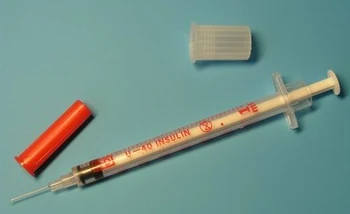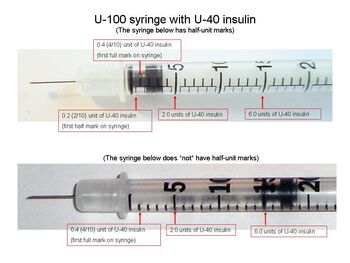
1ml or 1cc U-40 insulin syringe by BD.
U40 syringes are intended for use with U40 (40 units per cc) insulin. The "units" therefore appear larger on a U40 syringe, making fine doses easier to measure than on a U100 syringe. But note -- 1/2cc remains 1/2 cc. Comparing two 1/2cc syringes side by side, you will see that the units on the U40 syringe appear larger than that of the U100 syringe. If you were to take the two syringes and fill them with insulin or fluid, both the U100 and the U40 syringe would each hold 1/2cc of it.
Cubic centimeters (cc's) and milliliters (mL's) are interchangable, so syringes marked 1ml equals 1cc; 0.5 ml equals 1/2cc. 3/10cc equals 0.3ml. [1]
General information and an overview of syringes at the link.
Barrel[]

Caninsulin 2ml (2cc) syringes which hold a maximum of 80 IU of U40 insulin.
U40 syringes are available in 4 barrel sizes: 2cc (2ml), 1cc (1ml), 1/2cc (0.5ml), and 3/10cc (0.3ml). The size refers to the maximum volume of insulin the syringe will hold. A 3/10cc-0.3ml syringe is available in UltiCare brand only. The 2cc (2ml) syringe was introduced in early 2007 in the UK by Intervet for Caninsulin; this appears to be the only market the larger syringes are sold in. [2][3]
|
U-40 Syringe Sizes | |
|---|---|
| 2cc (2ml) Syringe [4] | |
| Holds maximum: | 80 units |
| Numbered in: | 5 unit increments |
| Smallest line measures: | 1 unit |
| Barrel Markings in: | Red: Caninsulin [5] |
| 1cc (1ml) Syringe | |
| Holds maximum: | 40 units |
| Numbered in: | 5 unit increments |
| Smallest line measures: | 1 unit |
| Barrel Markings in: | Red: BD, Caninsulin Black: Vetsulin, Ulti-Care color ?: MVP [6][7] |
| 1/2cc (0.5ml) Syringe | |
| Holds maximum: | 20 units |
| Numbered in: | 5 unit increments |
| Smallest line measures: | 1 unit |
| Barrel Markings in: | Red: BD, Caninsulin Black: Vetsulin, Ulti-Care color ?: MVP [8][9] |
| 3/10cc (0.3ml) Syringe [10] | |
| Holds maximum: | 12 units |
| Numbered in: | 5 unit increments |
| Smallest line measures: | 1 unit |
| Barrel Markings in: | Black: Ulti-Care |
Some brands of U40 syringes (Caninsulin, [11] BD) also have all red barrel markings. Intervet branded Vetsulin syringes and Ulti-Care do not; theirs are in black like those of U100 syringes. [12]
Needle and Gauge[]
U40 insulin syringes are available in standard 1/2" length with a choice of either 28 or 29 gauge needles. The thinnest gauge U40 syringe currently available in the US is 29. [13] BD markets U-40 syringes with 30 gauge needles outside of the US under its MicroFine brand name. [14][15] The higher the gauge number, the thinner the needle. [16] AAHA recommends 12.7 mm or 1/2", standard length needles at 29 gauge. [17]
Conversion[]

Use of U-40 insulin in U-100 syringes. Top syringe is a 3/10 cc (maximum 30 units) syringe with half-scale (half unit) markings. Bottom syringe is a 3/10 cc (maximum 30 units) syringe with no half-scale (half unit) markings.
Though it's not recommended by veterinarians, some caregivers use a U100 syringe with a U40 insulin. That requires “converting” the U40 concentration to a U100 strength. [18] See the conversion table. If you choose to use the U100 syringes for U40 insulin, a fast way to calculate the right amount of units is to multiply the number of U40 units given by 2.5.
The advantage of doing this conversion is the possibility of greater precision for low-dose animals -- precise dose increments of 0.2 units are possible with half-unit marked U100 syringes (if your insulin is U40). On the other hand, if you find the conversion confusing, it's best not to try -- it can be extremely dangerous to get this math wrong.
|
Conversion Chart for Using U-40 Insulin With U-100 Syringes [19] | |
|---|---|
| To get this many units of U-40 insulin | Fill a U-100 syringe to this mark |
| 0.25 | 0.6 |
| 0.50 | 1.3 |
| 0.75 | 1.9 |
| 1.00 | 2.5 |
| 1.25 | 3.1 |
| 1.50 | 3.8 |
| 1.75 | 4.4 |
| 2.00 | 5.0 |
| 2.25 | 5.6 |
| 2.50 | 6.3 |
| 2.75 | 6.9 |
| 3.00 | 7.5 |
| 3.25 | 8.1 |
| 3.50 | 8.8 |
| 3.75 | 9.4 |
| 4.00 | 10.0 |
| 4.25 | 10.6 |
| 4.50 | 11.3 |
| 4.75 | 11.9 |
| 5.00 | 12.5 |
| 5.25 | 13.1 |
| 5.50 | 13.8 |
| 5.75 | 14.4 |
| 6.00 | 15.0 |
| 6.25 | 15.6 |
| 6.50 | 16.3 |
| 6.75 | 16.9 |
| 7.00 | 17.5 |
| 7.25 | 18.1 |
| 7.50 | 18.8 |
| 7.75 | 19.4 |
| 8.00 | 20.0 |
| 8.25 | 20.6 |
| 8.50 | 21.3 |
| 8.75 | 21.9 |
| 9.00 | 22.5 |
| 9.25 | 23.1 |
| 9.50 | 23.8 |
| 9.75 | 24.4 |
| 10.00 | 25.0 |
| 10.25 | 25.6 |
| 10.50 | 26.3 |
| 10.75 | 26.9 |
| 11.00 | 27.5 |
| 11.25 | 28.1 |
| 11.50 | 28.8 |
| 11.75 | 29.4 |
| 12.0 | 30.0 |
References[]
- ↑ Milliliter to Cubic Centimeter Converter. Calculateme.com.
- ↑ Intervet Launches new 2ml Caninsulin syringe. Intervet (2 December 2007).
- ↑ Caninsulin 2ml syringes. Animal Medication Direct.
- ↑ Caninsulin 2ml syringes sold in the UK.
- ↑ Caninsulin 2 ml syringes-UK.
- ↑ MVP U 40 syringe.
- ↑ Easy Touch/MVP Vet Syringes.
- ↑ MVP U 40 syringe.
- ↑ Easy Touch/MVP Vet Syringes.
- ↑ U-40 3/10cc Syringes. VetRxSupply.
- ↑ Caninsulin Syringes-Italy-Red Barrel Markings Easily Seen in Photo.
- ↑ Ulti-Care U40 Syringes.
- ↑ Insulin Syringes for Dogs. BD Diabetes.
- ↑ 1/2 cc (0.5 ml) Syringes with 30 Gauge Needles-Photo. BD Diabetes-Germany.
- ↑ 1cc (1ml) Syringes with 30 Gauge Needles-Photo. BD Diabetes-Germany.
- ↑ Insulin Syringe Needles. BD Diabetes.
- ↑ Ruchinsky, Renee, et. al. (2010). Diabetes Management Guidelines for Dogs and Cats-page 9. American Animal Hospital Association.
- ↑ Using Caninsulin With U100 Syringes-Page 2. Intervet.
- ↑ U 40 Insulin/U 100 Syringe Conversion Chart. MediVet.
More Information[]
- Diabetes Mellitus Washington State University
Good general information--photos and tips about how to draw insulin. - Needle Re-Use BD Diabetes
- Childrenwithdiabetes.com-U40 & U100 Insulin
- ReliOn Insulin Syringe Needle Lengths-U 100 insulin
- ReliOn Insulin Syringes-U 100 insulin-FAQ's
- More Tips on Drawing Insulin From a Disposable Pen